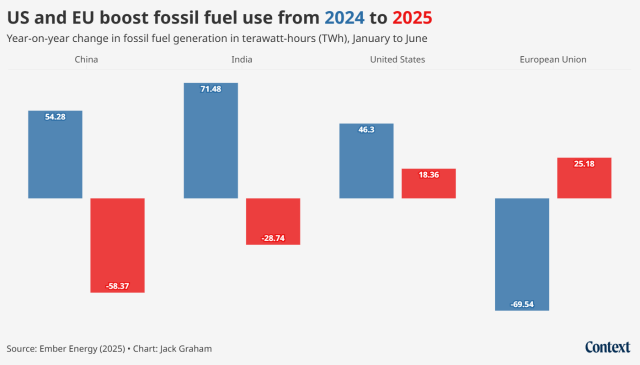 | Know better. Do better. |  | Climate. Change.News from the ground, in a warming world |
|
| | | By Jack Graham | Climate Journalist | | |
|  |
| A clean energy future?
You might have missed it in a busy news week, but something important happened the other day:
Renewable energy overtook coal as the world's biggest electricity source. For the first time ever.
Thanks to a surge in solar power, renewables supplanted coal in the global energy mix in the first half of this year, according to the think-tank Ember Energy.
I asked Gareth Redmond-King of the Energy and Climate Intelligence Unit, a UK-based think-tank, what was driving the change.
"This is now being driven by market imperatives," he told me. "Profit lies in a clean energy future, whilst a fossil fuel future contains only growing costs."
In other words, renewables are more affordable than ever and, despite a backlash against clean energy in some parts of the world, the horse has bolted.
Within the global data, though, there are warning signs. Since Donald Trump's presidency, for example, the International Energy Agency's forecast for U.S. renewable energy growth between now and 2030 has been revised down by nearly 50%.  Thomson Reuters Foundation/Jack Graham |
Redmond-King said global renewables momentum was "leaving the U.S. behind", pointing out that U.S. fossil fuel exports of $80 billion were much smaller than China's clean energy tech exports of $120 billion.
An increasing amount of those exports are heading to Africa, where the solar boom is just showing signs of beginning.
In South Africa, my colleague Kim Harrisberg found a coal community where a new village could provide a model.
|
Solar CityIn Nomzamo, a settlement in South Africa's coal heartland of just 412 households, a solar project has provided locals with a glimpse into a renewable future.
While the country has struggled to speed up its energy transition, a project by local charities has replaced a dangerous, unrehabilitated open-pit coal mine with a
settlement with access to clean power.
I asked Kim what it was like visiting the settlement, five years after first reporting on the area for a story on coal mining and climate change.
"As journalists, we see a lot of things that don’t work, so seeing Nomzamo’s solar initiative succeeding - despite it being small in size - was a really heartwarming reporting trip,” she said.
 Zethu Hlatshwayo, Khuthala's spokesperson, points to Nomzamo from a viewpoint, Ermelo, South Africa, July 9, 2025. Thomson Reuters Foundation/Kim Harrisberg |
Funded by New Zealand, France and Denmark, the project has brought solar bricks - a stackable lithium-ion battery charged by the sun - to more than 400 homes in two years to power their lights and cell phones.
It's not a perfect solution - some residents still rely on illegal connections to the coal-powered grid - but could become a model for how to shift away from coal locally.
"If Nomzamo, in the coal heartlands, can accept that coal has an expiry date and renewables are a part of their future - then most parts of South Africa can do the same,” Kim told me.
More broadly, the outlook is less glossy. Countries in Africa are far behind leaders like China and India in clean energy production.
"Emerging economies face real challenges replacing coal whilst expanding energy access and meeting growing energy demand," said Julia Skorupska, head of the secretariat of the Powering Past Coal Alliance, a global coalition of governments and businesses.
Global South countries can accelerate the transition to clean power with international support, but early planning and strong policies are needed, she told me.
Will communities like Nomzamo get the support they need from their governments to take advantage of the continent's huge solar potential?
What happens in the next few years will be crucial, and we'll be watching closely.
See you next time,
Jack |
|
|
|